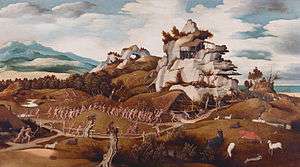Zuni-Cibola Complex
- For popular culture references to Cibola legends, see Seven Cities of Gold (myth)
|
Zuni-Cibola Complex | |
| Nearest city | Zuni, New Mexico |
|---|---|
| NRHP Reference # | 74002267 |
| Significant dates | |
| Added to NRHP | December 2, 1974[1] |
| Designated NHLD | December 2, 1974[2] |

Zuni-Cibola Complex, which comprises Hawikuh, Yellow House, Kechipbowa, and Great Kivas, is a set of sites near Zuni, New Mexico.
The Zuni-Cibola Complex comprises a series of sites on the Zuni Reservation, containing house ruins, kivas, pictographs, petroglyphs, trash mounds, and a mission church and convent. They have proven to be an important source of material providing evidence for the fusion, in prehistoric times, of Mogollon and Anasazi traits that led in subsequent centuries to a distinct Zuni culture.[2]
It was declared a National Historic Landmark District in 1974.[2][3]
Hawikuh Ruins is itself a National Historic Landmark.
History
The name Cibola first entered recorded history in 1539, when Spaniards in southern New Spain (present day Mexico and Central America) heard rumors that there was a province by this name with "Seven Cities of Gold", located across the desert hundreds of leagues to the north. These rumors were largely caused by reports given by the four shipwrecked survivors of the failed Narváez expedition, including Álvar Núñez Cabeza de Vaca and an African slave named Esteban Dorantes, or Estevanico. Upon finally returning to New Spain, the adventurers said they had heard stories from Natives about cities with great and limitless riches.
Upon hearing the castaways' tales, Viceroy Antonio de Mendoza organized an expedition headed by the Franciscan friar Marcos de Niza, who took Estevanico as his guide. During the voyage, in a place called Vacapa (probably located somewhere around the state of Sonora), de Niza sent Estevanico to scout ahead. A short while later, Estevanico met a monk who had heard stories from the Natives about seven cities called "Cibola", said to be overflowing with riches.
Estevanico did not wait for the friar, but instead continued traveling until he reached Cibola (Háwikuh, now in New Mexico), where, at the hands of the Zuni tribe, he met his death, and his companions were forced to flee.
Marcos de Niza returned to Mexico City and said that the expedition had continued even after the death of Estevanico. He claimed that they had seen Cíbola from a great distance, and that it was larger than Tenochtitlan; in this city, the people used dishes of gold and silver, decorated their houses with turquoise, and had gigantic pearls, emeralds, and other beautiful gems. It is now believed by some historians that the mica-inflected clay of the adobe pueblos may have created an optical illusion when inflamed by the setting sun, thus fueling the tale.
Upon hearing this news, the Viceroy de Mendoza wasted no time in organizing a large military expedition to take possession of the riches that the monk had described with such vivid detail. Upon the Viceroy's command, Francisco Vázquez de Coronado began his expedition, taking the friar Marcos de Niza as his guide. Coronado left with a small group of explorers from Culiacán on April 22, 1540.
When Coronado arrived at Hawikuh pueblo, which the chroniclers called Cevola, Tzibola, or Cibola, he discovered that Marcos de Niza's stories were lies, and that there were in fact no treasures as the friar had described. He also found that, contrary to the friar's account, the sea was not within view from that region, but it was instead many days' journey away. Nevertheless, Coronado occupied the region by military force and used it as a base for future explorations.
The entire "province of Cibola" (Zuni-inhabited territory) was said to consist of seven modest pueblos or villages, which were fully described in the contemporary documents and reports. It has been conjectured that the name comes from a Zuni word meaning "buffalo".
References
- ↑ National Park Service (2008-04-15). "National Register Information System". National Register of Historic Places. National Park Service.
- 1 2 3 "Zuni-Cibola Complex". National Historic Landmark summary listing. National Park Service. Retrieved 2008-06-12.
- ↑ Note: A National Register of Historic Places Inventory-Nomination document should be available upon request from the National Park Service for this site, but it appears not to be available on-line from the NPS Focus search site.
- Crampton, C. Gregory. The Zunis of Cibola. Salt Lake City: University of Utah Press, 1977.
External links
- The journey of Coronado, 1540-1542, from the city of Mexico to the Grand Canon of the Colorado and the buffalo plains of Texas, Kansas and Nebraska, as told by himself and his followers - Complete primary documents pertaining to Coronado's expeditions, translated by George Parker Winship, at Portal to Texas History.
- Zuni-Cibola National Historical Park, the Park that Died A-Borning, National Parks Traveler, June 28, 2009
- Journal of Marco de Nicas Translation of Marco de Nicas' (Niza) 1539 journal of his visit to Ceuola (Cibola) where Stephan (Estevanico) was killed.
- Journal of Alvar Nunez Translation of the journal of the 9 years Alvar Nunez spent wandering from Florida to the Pacific during the failed Narváez expedition.